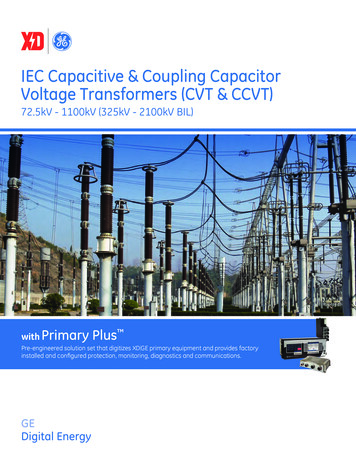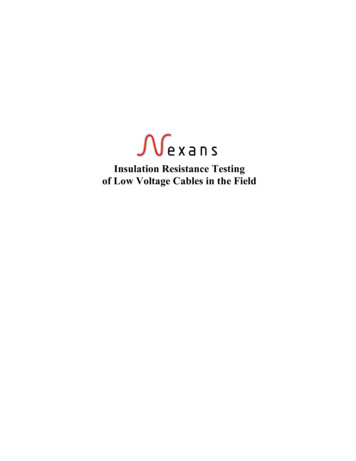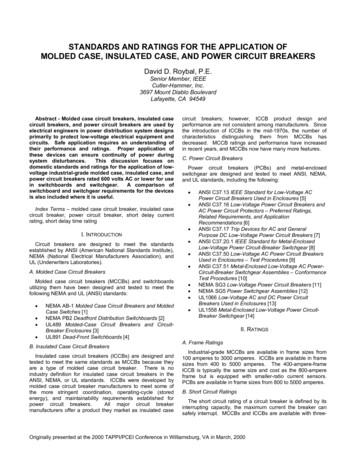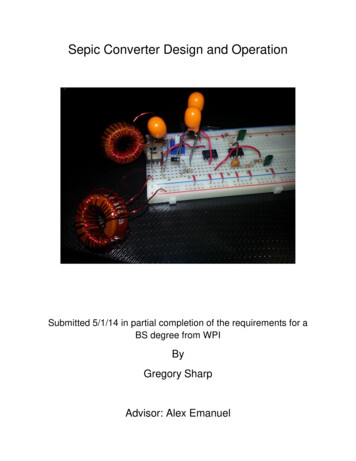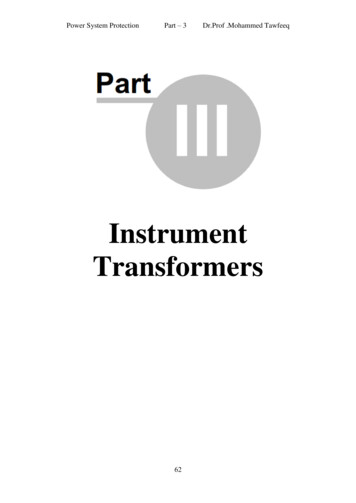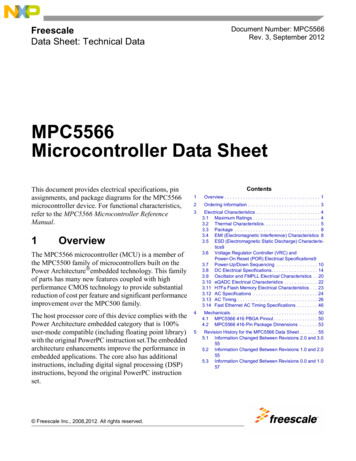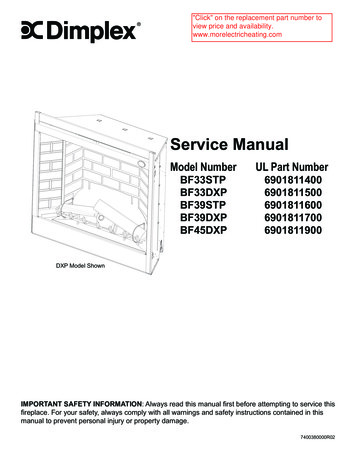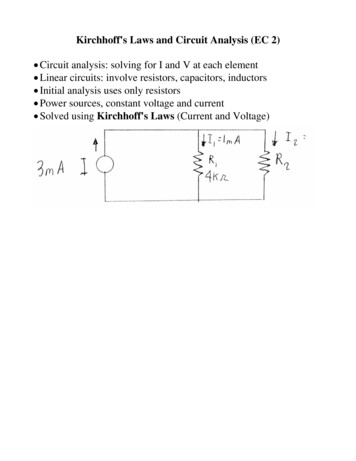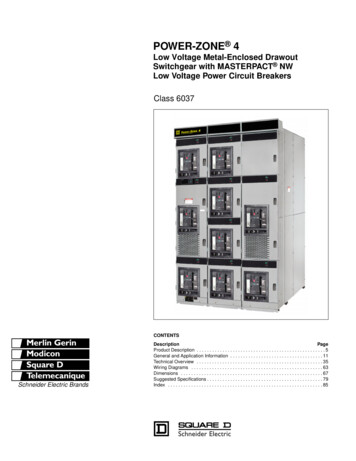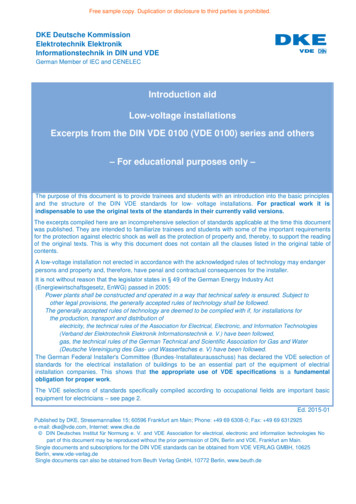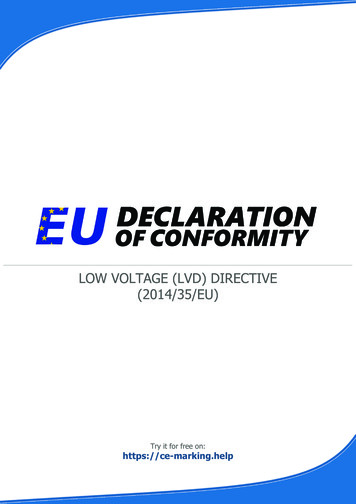
Transcription
LOW VOLTAGE (LVD) DIRECTIVE(2014/35/EU)Try it for free on:https://ce-marking.help
This Free of Charge application was designed to help manufacturers, consultants, notifiedbodies to keep under control the EU declaration of conformity.The application allows you to:Compose in few minutes declaration of conformity compliant with applicable directives;Search for a standard by keyword or synonyms or filtering by directive(s);Get the right standards form the list of harmonised standards;Take under control list of products, declarations of conformity, amended declarationsof conformity;Download declaration in word or PDF format, with your logo;Store all declarations on a secure server;Receive an alert when an harmonized standards change in the official journal;Automatically provide report (action list), when an official journal changes;Allow to work with one or more separate manufacturers;Take under control product made by assembly of products;Allow multiple users to access to the same work with different roles(view/edit/approve) declaration of conformity;Allow to add a QRCODE in the declaration of conformity so will be possible for users tocheck the last release of a declaration in our servers;Hundreds of experts are already using this software
29.3.2014ENOfficial Journal of the European UnionL 96/357DIRECTIVE 2014/35/EU OF THE EUROPEAN PARLIAMENT AND OF THE COUNCILof 26 February 2014on the harmonisation of the laws of the Member States relating to the making available on themarket of electrical equipment designed for use within certain voltage limits(recast)(Text with EEA relevance)framework for the marketing of products (5) lays downcommon principles and reference provisions intended toapply across sectoral legislation in order to provide acoherent basis for revision or recasts of that legislation.Directive 2006/95/EC should therefore be adapted tothat Decision.THE EUROPEAN PARLIAMENT AND THE COUNCIL OF THEEUROPEAN UNION,Having regard to the Treaty on the Functioning of the EuropeanUnion, and in particular Article 114 thereof,Having regard to the proposal from the European Commission,(4)This Directive covers electrical equipment designed foruse within certain voltage limits which is new to theUnion market when it is placed on the market; that isto say it is either new electrical equipment made by amanufacturer established in the Union or electricalequipment, whether new or second-hand, importedfrom a third country.(5)This Directive should apply to all forms of supply,including distance selling.(6)Economic operators should be responsible for thecompliance of electrical equipment with this Directive,in relation to their respective roles in the supply chain,so as to ensure a high level of protection of publicinterests, such as health and safety of persons, ofdomestic animals and property, and to guarantee faircompetition on the Union market.(7)All economic operators intervening in the supply anddistribution chain should take appropriate measures toensure that they only make available on the market elec trical equipment which is in conformity with thisDirective. It is necessary to provide for a clear andproportionate distribution of obligations whichcorrespond to the role of each economic operator inthe supply and distribution chain.(8)In order to facilitate communication between economicoperators, market surveillance authorities and consumers,Member States should encourage economic operators toinclude a website address in addition to the postaladdress.(9)The manufacturer, having detailed knowledge of thedesign and production process, is best placed to carryout the conformity assessment procedure. Conformityassessment should therefore remain solely the obligationof the manufacturer. There is no conformity assessmentprocedure in this Directive which requires the inter vention of a notified body.After transmission of the draft legislative act to the nationalparliaments,Having regard to the opinion of the European Economic andSocial Committee (1),Acting in accordance with the ordinary legislative procedure (2),Whereas:(1)(2)(3)A number of amendments are to be made to Directive2006/95/EC of the European Parliament and of theCouncil of 12 December 2006 on the harmonisationof the laws of Member States relating to electricalequipment designed for use within certain voltagelimits (3). In the interests of clarity, that Directiveshould be recast.Regulation (EC) No 765/2008 of the EuropeanParliament and of the Council of 9 July 2008 settingout the requirements for accreditation and marketsurveillance relating to the marketing of products (4)lays down rules on the accreditation of conformityassessment bodies, provides a framework for themarket surveillance of products and for controls onproducts from third countries, and lays down thegeneral principles of the CE marking.Decision No 768/2008/EC of the European Parliamentand of the Council of 9 July 2008 on a common(1) OJ C 181, 21.6.2012, p. 105.(2) Position of the European Parliament of of 5 February 2014 (not yetpublished in the Official Journal) and decision of the Council of20 February 2014.(3) OJ L 374, 27.12.2006, p. 10. Directive 2006/95/EC is the codifi cation of Council Directive 73/23/EEC of 19 February 1973 on theharmonization of the laws of Member States relating to electricalequipment designed for use within certain voltage limits (OJ L 77,26.3.1973, p. 29).(4) OJ L 218, 13.8.2008, p. 30.(5) OJ L 218, 13.8.2008, p. 82.
L 96/358(10)(11)(12)(13)(14)(15)ENOfficial Journal of the European UnionIt is necessary to ensure that electrical equipment fromthird countries entering the Union market comply withthis Directive, and in particular that appropriateconformity assessment procedures have been carriedout by manufacturers with regard to that electricalequipment. Provision should therefore be made forimporters to make sure that electrical equipment theyplace on the market comply with the requirements ofthis Directive and that they do not place on themarket electrical equipment which does not complywith such requirements or present a risk. Provisionshould also be made for importers to make sure thatconformity assessment procedures have been carriedout and that marking of electrical equipment and docu mentation drawn up by manufacturers are available forinspection by the competent national authorities.When placing electrical equipment on the market, everyimporter should indicate on the electrical equipment hisname, registered trade name or registered trade mark andthe postal address at which he can be contacted.Exceptions should be provided for in cases where thesize or nature of the electrical equipment does notallow it. This includes cases where the importer wouldhave to open the packaging to put his name and addresson the electrical equipment.The distributor makes electrical equipment available onthe market after it has been placed on the market by themanufacturer or the importer and should act with duecare to ensure that its handling of electrical equipmentdoes not adversely affect the compliance of the electricalequipment.Any economic operator that either places electricalequipment on the market under his own name ortrade mark or modifies electrical equipment in such away that compliance with this Directive may beaffected should be considered to be the manufacturerand should assume the obligations of the manufacturer.to update such information in respect of other economicoperators who have either supplied them with electricalequipment or to whom they have supplied electricalequipment.(16)This Directive should be limited to the expression of thesafety objectives. In order to facilitate conformityassessment with those objectives it is necessary toprovide for a presumption of conformity for electricalequipment which is in conformity with harmonisedstandards that are adopted in accordance with Regulation(EU) No 1025/2012 of the European Parliament and ofthe Council of 25 October 2012 on European Standard isation (1) for the purpose of expressing detailed technicalspecifications of those objectives.(17)Regulation (EU) No 1025/2012 provides for a procedurefor objections to harmonised standards where thosestandards do not entirely satisfy the safety objectivesset out in this Directive.(18)The harmonised standards relevant to this Directiveshould also take into account the United NationsConvention on the Rights of Persons with Disabilities (2).(19)The free movement of electrical equipment for whichharmonised standards do not exist should be achievedby applying the safety provisions of the internationalstandards laid down by the International ElectrotechnicalCommission or by applying national standards.(20)In order to enable economic operators to demonstrateand the competent authorities to ensure that electricalequipment made available on the market is in conformitywith the safety objectives it is necessary to provide forconformity assessment procedures. Decision No 768/2008/EC establishes modules for conformity assessmentprocedures, which include procedures from the least tothe most stringent, in proportion to the level of riskinvolved and the level of safety required. In order toensure inter-sectoral coherence and to avoid ad-hocvariants, conformity assessment procedures should bechosen from among those modules.(21)Manufacturers should draw up an EU declaration ofconformity to provide information required under thisDirective on the conformity of electrical equipmentwith this Directive and of other relevant Union harmon isation legislation.Distributors and importers, being close to the marketplace, should be involved in market surveillance taskscarried out by the competent national authorities, andshould be prepared to participate actively, providingthose authorities with all necessary information relatingto the electrical equipment concerned.Ensuring traceability of electrical equipment throughoutthe whole supply chain helps to make marketsurveillance simpler and more efficient. An efficienttraceability system facilitates market surveillance auth orities’ task of tracing economic operators who madenon-compliant electrical equipment available on themarket. When keeping the information required underthis Directive for the identification of other economicoperators, economic operators should not be required29.3.2014(1) OJ L 316, 14.11.2012, p. 12.(2) Approved by Council Decision 2010/48/EC of 26 November 2009concerning the conclusion, by the European Community, of theUnited Nations Convention on the Rights of Persons withDisabilities (OJ L 23, 27.1.2010, p. 35).
29.3.2014(22)(23)(24)(25)(26)(27)ENOfficial Journal of the European UnionTo ensure effective access to information for marketsurveillance purposes, the information required toidentify all applicable Union acts should be available ina single EU declaration of conformity. In order to reducethe administrative burden on economic operators, thatsingle EU declaration of conformity may be a dossiermade up of relevant individual declarations ofconformity.(28)Where the Member States and the Commission agree asto the justification of a measure taken by a MemberState, no further involvement of the Commissionshould be required, except where non-compliance canbe attributed to shortcomings of a harmonised standard.(29)In order to ensure uniform conditions for the implemen tation of this Directive, implementing powers should beconferred on the Commission. Those powers should beexercised in accordance with Regulation (EU)No 182/2011 of the European Parliament and of theCouncil of 16 February 2011 laying down the rulesand general principles concerning mechanisms forcontrol by Member States of the Commission’s exerciseof implementing powers (1).(30)The examination procedure should be used for theadoption of implementing acts with respect tocompliant electrical equipment which presents a risk tothe health or safety of persons or to other aspects ofpublic interest protection.(31)The Commission should adopt immediately applicableimplementing acts where, in duly justified cases relatingto compliant electrical equipment which presents a riskto the health or safety of persons, or to domestic animalsor to property, imperative grounds of urgency so require.(32)In line with established practice, the committee set up bythis Directive can play a useful role in examining mattersconcerning the application of this Directive raised eitherby its chair or by a representative of a Member State inaccordance with its rules of procedure.(33)When matters relating to this Directive, other than itsimplementation or infringements, are being examined,i.e. in a Commission expert group, the EuropeanParliament should in line with existing practice receivefull information and documentation and, where appro priate, an invitation to attend such meetings.(34)The Commission should, by means of implementing actsand, given their special nature, acting without the appli cation of Regulation (EU) No 182/2011, determinewhether measures taken by Member States in respect ofnon-compliant electrical equipment are justified or not.(35)Member States should lay down rules on penaltiesapplicable to infringements of provisions of nationallaw adopted pursuant to this Directive and ensure thatthose rules are enforced. The penalties provided forshould be effective, proportionate and dissuasive.The CE marking, indicating the conformity of electricalequipment, is the visible consequence of a whole processcomprising conformity assessment in a broad sense.General principles governing the CE marking are setout in Regulation (EC) No 765/2008. Rules governingthe affixing of the CE marking should be laid down inthis Directive.In order to ensure legal certainty, it is necessary to clarifythat rules on Union market surveillance and control ofproducts entering the Union market provided for inRegulation (EC) No 765/2008 apply to electricalequipment. This Directive should not prevent MemberStates from choosing the competent authorities to carryout those tasks.Member States should take all appropriate measures toensure that electrical equipment may be placed on themarket only if, when properly stored and used for itsintended purpose, or under conditions of use whichcan be reasonably foreseen, it does not endanger thehealth and safety of persons. Electrical equipmentshould be considered as non-compliant with the safetyobjectives laid down in this Directive only underconditions of use which can be reasonably foreseen,that is when such use could result from lawful andreadily predictable human behaviour.Directive 2006/95/EC already provides for a safeguardprocedure which applies only in the event ofdisagreement between Member States over measurestaken by a Member State. In order to increase trans parency and to reduce processing time, it is necessaryto improve the existing safeguard procedure, with aview to making it more efficient and drawing on theexpertise available in Member States.The existing system should be supplemented by aprocedure under which interested parties are informedof measures intended to be taken with regard to electricalequipment presenting a risk to the health or safety ofpersons or domestic animals, or to property. It shouldalso allow market surveillance authorities, in cooperationwith the relevant economic operators, to act at an earlierstage in respect of such electrical equipment.L 96/359(1) OJ L 55, 28.2.2011, p. 13.
L 96/360(36)(37)(38)(39)ENOfficial Journal of the European UnionIt is necessary to provide for reasonable transitionalarrangements that allow the making available on themarket, without the need to comply with furtherproduct requirements, of electrical equipment which hasalready been placed on the market in accordance withDirective 2006/95/EC before the date of application ofnational measures transposing this Directive. Distributorsshould therefore be able to supply electrical equipmentthat has been placed on the market, namely stock that isalready in the distribution chain, before the date of appli cation of national measures transposing this Directive.Since the objective of this Directive, namely to ensurethat electrical equipment on the market fulfils the safetyobjectives providing for a high level of protection ofhealth and safety of persons, and of domestic animalsand property, while guaranteeing the functioning of theinternal, market cannot be sufficiently achieved by theMember States but can rather, by reason of its scaleand effects, be better achieved at Union level, theUnion may adopt measures, in accordance with theprinciple of subsidiarity as set out in Article 5 of theTreaty on European Union. In accordance with theprinciple of proportionality, as set out in that Article,this Directive does not go beyond what is necessary inorder to achieve that objective.The obligation to transpose this Directive into nationallaw should be confined to those provisions whichrepresent a substantive amendment as compared to theearlier Directive. The obligation to transpose theprovisions which are unchanged arises under the earlierDirective.This Directive should be without prejudice to theobligations of the Member States relating to the timelimits for transposition into national law and the datesof application of the Directives set out in Annex V,29.3.2014Article 2DefinitionsFor the purposes of this Directive, the following definitions shallapply:(1) ‘making available on the market’ means any supply ofelectrical equipment for distribution, consumption or useon the Union market in the course of a commercialactivity, whether in return for payment or free of charge;(2) ‘placing on the market’ means the first making available ofelectrical equipment on the Union market;(3) ‘manufacturer’ means any natural or legal person whomanufactures electrical equipment or has electricalequipment designed or manufactured, and markets thatequipment under his name or trade mark;(4) ‘authorised representative’ means any natural or legalperson established within the Union who has received awritten mandate from a manufacturer to act on his behalfin relation to specified tasks;(5) ‘importer’ means any natural or legal person establishedwithin the Union who places electrical equipment from athird country on the Union market;(6) ‘distributor’ means any natural or legal person in thesupply chain, other than the manufacturer or theimporter, who makes electrical equipment available onthe market;(7) ‘economic operators’ means the manufacturer, the auth orised representative, the importer and the distributor;HAVE ADOPTED THIS DIRECTIVE:CHAPTER 1(8) ‘technical specification’ means a document that prescribestechnical requirements to be fulfilled by an electricalequipment;GENERAL PROVISIONSArticle 1Subject matter and scopeThe purpose of this Directive is to ensure that electricalequipment on the market fulfils the requirements providingfor a high level of protection of health and safety of persons,and of domestic animals and property, while guaranteeing thefunctioning of the internal market.This Directive shall apply to electrical equipment designed foruse with a voltage rating of between 50 and 1 000 V for alter nating current and between 75 and 1 500 V for direct current,other than the equipment and phenomena listed in Annex II.(9) ‘harmonised standard’ means harmonised standard asdefined in point (c) of point 1 of Article 2 of Regulation(EU) No 1025/2012;(10) ‘conformity assessment’ means the process demonstratingwhether the safety objectives referred to in Article 3 andset out in Annex I relating to electrical equipment havebeen fulfilled;(11) ‘recall’ means any measure aimed at achieving the return ofelectrical equipment that has already been made availableto the end-user;
29.3.2014ENOfficial Journal of the European Union(12) ‘withdrawal’ means any measure aimed at preventing elec trical equipment in the supply chain from being madeavailable on the market;(13) ‘Union harmonisation legislation’ means any Union legis lation harmonising the conditions for the marketing ofproducts;(14) ‘CE marking’ means a marking by which the manufacturerindicates that the electrical equipment is in conformitywith the applicable requirements set out in Union harmon isation legislation providing for its affixing.L 96/3612.Manufacturers shall draw up the technical documentationreferred to in Annex III and carry out the conformityassessment procedure referred to in Annex III or have itcarried out.Where compliance of electrical equipment with the safetyobjectives referred to in Article 3 and set out in Annex I hasbeen demonstrated by the conformity assessment procedurereferred to in the first subparagraph, manufacturers shall drawup an EU declaration of conformity and affix the CE marking.3.Manufacturers shall keep the technical documentationreferred to in Annex III and the EU declaration of conformityfor 10 years after the electrical equipment has been placed onthe market.Article 3Making available on the market and safety objectivesElectrical equipment may be made available on the Unionmarket only if, having been constructed in accordance withgood engineering practice in safety matters in force in theUnion, it does not endanger the health and safety of personsand domestic animals, or property, when properly installed andmaintained and used in applications for which it was made.The principal elements of the safety objectives are listed inAnnex I.Article 4Free movementThe Member States shall not impede, for the aspects covered bythis Directive, the making available on the market of electricalequipment which complies with this Directive.Article 5Supply of electricityIn relation to electrical equipment, the Member States shallensure that stricter safety requirements than the safety objectivesreferred to in Article 3 and set out in Annex I are not imposedby electricity supply bodies for connection to the grid, or forthe supply of electricity to users of electrical equipment.CHAPTER 2OBLIGATIONS OF ECONOMIC OPERATORS4.Manufacturers shall ensure that procedures are in place forseries production to remain in conformity with this Directive.Changes in product design or characteristics and changes in theharmonised standards referred to in Article 12, the internationalor national standards referred to in Articles 13 and 14, or inother technical specifications by reference to which conformityof electrical equipment is declared shall be adequately taken intoaccount.When deemed appropriate with regard to the risks presented byelectrical equipment, manufacturers shall, to protect the healthand safety of consumers, carry out sample testing of electricalequipment made available on the market, investigate, and, ifnecessary, keep a register of complaints, of non-conformingelectrical equipment and electrical equipment recalls, and shallkeep distributors informed of any such monitoring.5.Manufacturers shall ensure that electrical equipment whichthey have placed on the market bears a type, batch or serialnumber or other element allowing its identification, or, wherethe size or nature of the electrical equipment does not allow it,that the required information is provided on its packaging or ina document accompanying the electrical equipment.6.Manufacturers shall indicate on the electrical equipmenttheir name, registered trade name or registered trade markand the postal address at which they can be contacted or,where that is not possible, on its packaging or in a documentaccompanying the electrical equipment. The address shallindicate a single point at which the manufacturer can becontacted. The contact details shall be in a language easilyunderstood by end-users and market surveillance authorities.Article 6Obligations of manufacturers1.When placing their electrical equipment on the market,manufacturers shall ensure that it has been designed and manu factured in accordance with the safety objectives referred to inArticle 3 and set out in Annex I.7.Manufacturers shall ensure that the electrical equipment isaccompanied by instructions and safety information in alanguage which can be easily understood by consumers andother end-users, as determined by the Member State concerned.Such instructions and safety information, as well as anylabelling, shall be clear, understandable and intelligible.
L 96/362ENOfficial Journal of the European Union8.Manufacturers who consider or have reason to believe thatelectrical equipment which they have placed on the market isnot in conformity with this Directive shall immediately take thecorrective measures necessary to bring that electrical equipmentinto conformity, to withdraw it or recall it, if appropriate.Furthermore, where the electrical equipment presents a risk,manufacturers shall immediately inform the competentnational authorities of the Member States in which they madethe electrical equipment available on the market to that effect,giving details, in particular, of the non-compliance and of anycorrective measures taken.9.Manufacturers shall, further to a reasoned request from acompetent national authority, provide it with all theinformation and documentation in paper or electronic formnecessary to demonstrate the conformity of the electricalequipment with this Directive, in a language which can beeasily understood by that authority. They shall cooperate withthat authority, at its request, on any action taken to eliminatethe risks posed by electrical equipment which they have placedon the market.Article 7Authorised representatives1.A manufacturer may, by a written mandate, appoint anauthorised representative.The obligations laid down in Article 6(1) and the obligation todraw up technical documentation referred to in Article 6(2)shall not form part of the authorised representative’s mandate.2.An authorised representative shall perform the tasksspecified in the mandate received from the manufacturer. Themandate shall allow the authorised representative to do at leastthe following:(a) keep the EU declaration of conformity and the technicaldocumentation at the disposal of national marketsurveillance authorities for 10 years after the electricalequipment has been placed on the market;(b) further to a reasoned request from a competent nationalauthority, provide that authority with all the informationand documentation necessary to demonstrate theconformity of electrical equipment;(c) cooperate with the competent national authorities, at theirrequest, on any action taken to eliminate the risks posed byelectrical equipment covered by the authorised represen tative’s mandate.Article 8Obligations of importers1.Importers shall place only compliant electrical equipmenton the market.29.3.20142.Before placing electrical equipment on the marketimporters shall ensure that the appropriate conformityassessment procedure has been carried out by the manufacturer.They shall ensure that the manufacturer has drawn up thetechnical documentation, that the electrical equipment bearsthe CE marking and is accompanied by the required documents,and that the manufacturer has complied with the requirementsset out in Article 6(5) and (6).Where an importer considers or has reason to believe thatelectrical equipment is not in conformity with the safetyobjectives referred to in Article 3 and set out in Annex I, heshall not place the electrical equipment on the market until ithas been brought into conformity. Furthermore, where the elec trical equipment presents a risk, the importer shall inform themanufacturer and the market surveillance authorities to thateffect.3.Importers shall indicate on the electrical equipment theirname, registered trade name or registered trade mark and thepostal address at which they can be contacted or, where that isnot possible, on its packaging or in a document accompanyingthe electrical equipment. The contact details shall be in alanguage easily understood by end-users and market surveillanceauthorities.4.Importers shall ensure that the electrical equipment isaccompanied by instructions and safety information in alanguage which can be easily understood by consumers andother end-users, as determined by the Member State concerned.5.Importers shall ensure that, while electrical equipment isunder their responsibility, its storage or transport conditions donot jeopardise its compliance with the safety objectives referredto in Article 3 and set out in Annex I.6.When deemed appropriate with regard to the riskspresented by electrical equipment, importers shall, to protectthe health and safety of consumers, carry out sample testingof electrical equipment made available on the market, inves tigate and, if necessary, keep a register of complaints, of nonconforming electrical equipment and electrical equipmentrecalls, and shall keep distributors informed of any such moni toring.7.Importers who consider or have reason to believe thatelectrical equipment which they have placed on the market isnot in conformity with this Directive shall immediately take thecorrective measures necessary to bring that electrical equipmentinto conformity, to withdraw it or recall it, if appropriate.Furthermore, where the electrical equipment presents a risk,importers shall immediately inform the competent nationalauthorities of the Member States in which they made the elec trical equipment available on the market to that effect, givingdetails, in particular, of the non-compliance and of anycorrective measures taken.
29.3.2014ENOfficial Journal of the European Union8.Importers shall, for 10 years after the electrical equipmenthas been placed on the market, keep a copy of the EUdeclaration of conformity at the disposal of the marketsurveillance authorities and ensure that the technical documen tation can be made available to those authorities, upon request.9.Importers shall, further to a reasoned request from acompetent national authority, provide it with all theinformation and documentation in paper or electronic formnecessary to de
Download declaration in word or PDF format, with your logo; . DIRECTIVE 2014/35/EU OF THE EUROPEAN PARLIAMENT AND OF THE COUNCIL of 26 February 2014 on the harmonisation of the laws of the Member States relating to the making available on the market of electrical equipment designed for use within certain voltage limits (recast)

